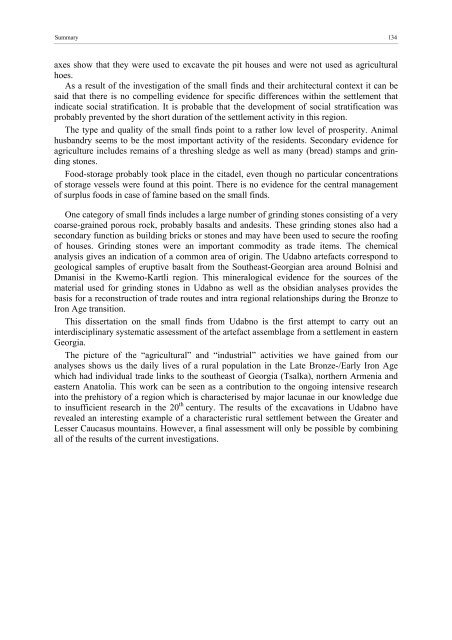PDF 44.747kB - TOBIAS-lib - Universität Tübingen
PDF 44.747kB - TOBIAS-lib - Universität Tübingen
PDF 44.747kB - TOBIAS-lib - Universität Tübingen
Erfolgreiche ePaper selbst erstellen
Machen Sie aus Ihren PDF Publikationen ein blätterbares Flipbook mit unserer einzigartigen Google optimierten e-Paper Software.
Summary 134<br />
axes show that they were used to excavate the pit houses and were not used as agricultural<br />
hoes.<br />
As a result of the investigation of the small finds and their architectural context it can be<br />
said that there is no compelling evidence for specific differences within the settlement that<br />
indicate social stratification. It is probable that the development of social stratification was<br />
probably prevented by the short duration of the settlement activity in this region.<br />
The type and quality of the small finds point to a rather low level of prosperity. Animal<br />
husbandry seems to be the most important activity of the residents. Secondary evidence for<br />
agriculture includes remains of a threshing sledge as well as many (bread) stamps and grinding<br />
stones.<br />
Food-storage probably took place in the citadel, even though no particular concentrations<br />
of storage vessels were found at this point. There is no evidence for the central management<br />
of surplus foods in case of famine based on the small finds.<br />
One category of small finds includes a large number of grinding stones consisting of a very<br />
coarse-grained porous rock, probably basalts and andesits. These grinding stones also had a<br />
secondary function as building bricks or stones and may have been used to secure the roofing<br />
of houses. Grinding stones were an important commodity as trade items. The chemical<br />
analysis gives an indication of a common area of origin. The Udabno artefacts correspond to<br />
geological samples of eruptive basalt from the Southeast-Georgian area around Bolnisi and<br />
Dmanisi in the Kwemo-Kartli region. This mineralogical evidence for the sources of the<br />
material used for grinding stones in Udabno as well as the obsidian analyses provides the<br />
basis for a reconstruction of trade routes and intra regional relationships during the Bronze to<br />
Iron Age transition.<br />
This dissertation on the small finds from Udabno is the first attempt to carry out an<br />
interdisciplinary systematic assessment of the artefact assemblage from a settlement in eastern<br />
Georgia.<br />
The picture of the “agricultural” and “industrial” activities we have gained from our<br />
analyses shows us the daily lives of a rural population in the Late Bronze-/Early Iron Age<br />
which had individual trade links to the southeast of Georgia (Tsalka), northern Armenia and<br />
eastern Anatolia. This work can be seen as a contribution to the ongoing intensive research<br />
into the prehistory of a region which is characterised by major lacunae in our knowledge due<br />
to insufficient research in the 20 th century. The results of the excavations in Udabno have<br />
revealed an interesting example of a characteristic rural settlement between the Greater and<br />
Lesser Caucasus mountains. However, a final assessment will only be possible by combining<br />
all of the results of the current investigations.
















